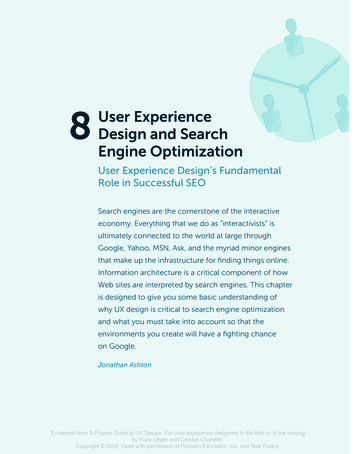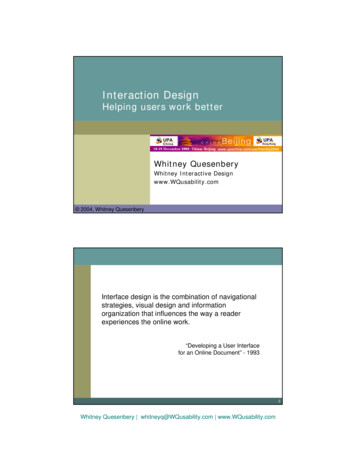
Transcription
8User ExperienceDesign and SearchEngine OptimizationUser Experience Design’s FundamentalRole in Successful SEOSearch engines are the cornerstone of the interactiveeconomy. Everything that we do as “interactivists” isultimately connected to the world at large throughGoogle, Yahoo, MSN, Ask, and the myriad minor enginesthat make up the infrastructure for finding things online.Information architecture is a critical component of howWeb sites are interpreted by search engines. This chapteris designed to give you some basic understanding ofwhy UX design is critical to search engine optimizationand what you must take into account so that theenvironments you create will have a fighting chanceon Google.Jonathan AshtonExcerpted from A Project Guide to UX Design: For user experience designers in the field or in the makingby Russ Unger and Carolyn Chandler.Copyright 2009. Used with permission of Pearson Education, Inc. and New Riders.
Introduction to SEOSimply put, search engine optimization is the process of developing andmaintaining a Web asset with the intention of gaining and keeping top placement on public search engines for specifically targeted keyword phrases.Search engine optimization (SEO) is like a martial art, a process of learningand doing that is never complete. Even a master can progress further usingobserved behavior or learned method. As long as there are search enginesand Web sites interested in selling something to the people searching, therewill be a role for search engine optimization.SEO relies on three fundamental areas for improvement and influence: The critical group of things that the professional user experience designercan influence—site infrastructure, technology, and organizational principles Content and all the keyword issues that relate to optimized words whichthe search engines can see Links, or link popularity—the quantity and quality of links that point at yoursite from other sites, as well as the organizational structure of the linksinside the siteWe will take apart each of these three areas and examine them from theUX designer’s perspective, to better equip you for the optimization challenges that lie ahead.Why Is SEO Important?It is interesting that even today we need to explain the relevance of searchengine optimization. Clients tend to understand on some level that it isimportant for their Web sites to attract targeted visitors from the naturalsearch results of the main search engines, but beyond that it is difficult formost interactive marketers to understand the impact SEO can have.Data on global search volume is available from a variety of sources, but whatis most important to understand is that, whatever the source, the numbersare simply huge, and the year-over-year increases are always in double digits. For the most part, every quarter the global volume of searches increases.When Google first launched in 1998, 10,000 searches a day was a huge volume and placed an incredible burden on the beta version of the system.Introduction to SEOExcerpted from A Project Guide to UX Design: For user experience designers in the field or in the makingby Russ Unger and Carolyn Chandler.Copyright 2009. Used with permission of Pearson Education, Inc. and New Riders.127
Hitwise (www.hitwise.com) reports that Google and its affiliates (includingAOL and YouTube) own the lion’s share of searches globally, with nearly 72percent of U.S. searches performed in November 2008. Yahoo is a distantsecond, with nearly 18 percent, and MSN and Ask.com trail in at 4 percentand 3 percent, respectively. Internationally, Google is even more dominant:Its market share reaches more than 80 percent in many markets.Note For more background on Google’s early days, see The Google Story, by David A.Vise and Mark Malseed (Delta, 2008).According to comScore (www.comscore.com), in 2008 there were easily more than 60billion searches per month performed globally by 750 million people, with over 18 billion searches performed in the United States alone. To put it another way, 95 percent ofInternet users use a search engine at least once a month, with a global average of morethan 80 searches per month.Aside from these remarkable volume numbers, what does this really meanon a practical level to interactive marketers? Simply put, if you are not reaching your target customers when they are searching for your products orservices, your competition is getting the opportunity to sell to them.Look at your site analytics and think of the issue this way: How much morerevenue would the site generate if there was a 10 percent increase in strategically targeted traffic? What about a 100 percent increase? Or 1000 percent? If your site is not generating meaningful traffic through natural search,then SEO is a requirement.A little investment in SEO can go a very long way, particularly if the interactive marketing effort to date has focused on purchasing clicks through sponsor listings. We have seen sites achieve a return on investment of 35 to 1 onmonthly SEO expenditures. If you are paying the search engine companiesfor traffic from sponsored listings but you are not investing in natural traffic,you are really limiting yourself to about 10 percent of the opportunity. Thinkof your own search behavior: When was the last time you clicked throughmore than one or two of the paid sponsor listings in a search result?Any discussion of why SEO is important and why it is here to stay could goon for chapters. Suffice it to say that Google is not going anywhere but up,and that effective interactive marketing must include search engine optimization as a core component of competent execution.128ChapteR 8: User Experience Design and Search Engine OptimizationExcerpted from A Project Guide to UX Design: For user experience designers in the field or in the makingby Russ Unger and Carolyn Chandler.Copyright 2009. Used with permission of Pearson Education, Inc. and New Riders.
Important Basic ResourcesExpertise emerges from a well-rounded education. The professional whosimply focuses on his or her specialty loses perspective on everything elsearound. That is why it is imperative that every interactivist spend at least afew minutes learning about SEO. Although there is no official set of guidelines, Google has been kind enough to provide some very salient resources.If you’re interested at all in getting better search engine performance fromyour efforts, check out these links: Webmasters/Site Owners Help: Search Engine /answer.py?hl en&answer 35291 Webmasters/Site Owners Help: Webmaster Guidelines: Quality nswer.py?hl en&answer 35769 Search Engine Optimization Starter -optimization-starter-guide.pdfIf that is not enough, drown yourself in newsletters and blogs. Start atSEOmoz.org and dig down. Just remember, as in all other things in life, if itsounds too good to be true, then it probably is.Site Technology, Design,and InfrastructureSearch engines are essentially Web 1.0.5 technology that is firmly implantedin the Web 2.0 world. The basic premise of the search engine has changedlittle since the World Wide Web Wanderer was launched in 1993 to crawl theWeb and build the first Web search engine. Essentially every search engine hasan application alternately called a crawler, spider, or bot that finds and followslinks, sending back to the database a copy of the assets that it can see. Thedatabase is then analyzed according to the search engine’s proprietary algorithm. Using these rules, a Web asset is indexed and then ranked according tohow well it scores on that search engine’s particular score card. In this ratherstraightforward process are a myriad of pitfalls for the UX designer.Site Technology, Design, and InfrastructureExcerpted from A Project Guide to UX Design: For user experience designers in the field or in the makingby Russ Unger and Carolyn Chandler.Copyright 2009. Used with permission of Pearson Education, Inc. and New Riders.129
Understanding these core relationships will enable you to see your sitethrough the eyes of the search engines. An optimized Web site relies on astructure and technology that facilitates the movement of the search enginespiders. Likewise, many decisions about handling content determine howwell the search engines ranks the resulting efforts. As a result, much of thisis predetermined by the decisions that are made in wireframes and in thediscussions that take place around how to style and manage content.Flash, Ajax, JavaScript, and Other Scripted ContentToday’s dynamic and interactive Web design relies on technologies that arenot at all friendly to the needs of the search engines. There is a widening gapbetween what search engines can see and what designers can do. It is upto the UX designer to be sure that the strategic plans for dynamic, designintensive sites are deployed so that both the search engines and the usersget the best possible experiences.Having a fundamental understanding of how search engines interact withthis kind of content will help you to decide when to deploy it and where tocompensate for its weaknesses. It is entirely possible to build an optimizedsite that relies heavily on scripted content if the appropriate compensationsare in place at the beginning of the process. It is substantially more difficultto build static or indexable content once the site is built and live. So make aforceful argument for static content, on the grounds of usability and for thesake of the search engines’ crawlers. It may seem like extra work up front,but the return on investment is exponential.FlashFlash content is technically “indexable.” There have been some recentadvances in the ability of the search engines to see into Flash files to findthe text and links that are built into these assets. Although this content isindexed, have you ever seen an all-Flash asset win top placement in thesearch results? You probably haven’t because it’s risky for search engines toopen themselves up to full compatibility with Flash. Let’s assume that thesearch engines could completely see all of the links and text content that isembedded inside the SWFobject. What prevents an unethical (or “black hat”)optimizer from putting apples in the text layers of the object while showing130ChapteR 8: User Experience Design and Search Engine OptimizationExcerpted from A Project Guide to UX Design: For user experience designers in the field or in the makingby Russ Unger and Carolyn Chandler.Copyright 2009. Used with permission of Pearson Education, Inc. and New Riders.
oranges to the human user viewing the fully compiled assets through abrowser? How can you deep link into a Flash asset without it being fullycompiled? These fundamental vulnerabilities will remain until the searchengines can reach some level of artificial intelligence that can tell that animage is a picture of a horse without some associated text that says “this is apicture of a horse.”To architect a Flash Web site that is compatible with search engines, youmust add a static layer of content that duplicates the Flash content. Leavingaside the needs of search engines for the moment, a static layer of content isa key for compliance with usability requirements. Think of the search engineas the person who is viewing Web content over a dial-up connection or isusing a screen reader browser. These people may be the lowest commondenominator, and it is possible that the strategy behind your Web development discounts this very small percentage of human users. But when youdiscount this handful of people, you also discount GoogleBot and YahooSlurp—the two most important visitors to your site, since they are the crawlers that will enable the major search engines to index your site. If no textwords or spiderable links are visible to the search engines, your content willinevitably not be findable through meaningful search results.A static layer can be accomplished in a number of ways. To comply withsearch engine requirements, the static layer of content needs to mirror theFlash content. This is not an opportunity to show the search engines something different than what is deployed in the Flash; if you do that you areviolating the spirit of the game and standing squarely on the dark side.The ideal way to embed Flash content into a static layer is to use SWFobjectso that both the Flash and static content can live on the same URL. This willallow the search engine to find the static content and the Flash-enabledbrowser to display the animation instead of the static content. If at all possible, do not use redirecting so that you can conserve the popularity of thelink that is pointing to the Flash content. Google Code provides a simple setof instructions for implementing this straightforward piece of JavaScript athttp://code.google.com/p/swfobject.There is another option that runs on the gray side of SEO. Cloaking can be adirty word to SEO purists, but if you approach the following challenges fromthe right side you can have some cake and eat it too.Site Technology, Design, and InfrastructureExcerpted from A Project Guide to UX Design: For user experience designers in the field or in the makingby Russ Unger and Carolyn Chandler.Copyright 2009. Used with permission of Pearson Education, Inc. and New Riders.131
Cloaking takes advantage of user agent detection, detecting search enginecrawlers as they visit a Web site and routing them to static pages to index.But when a human visitor sees the same page in search results and clicksthe link, the Web site detects that the user agent is a human with a Flashenabled browser and shows that person the dynamic experience on acompletely separate URL. The crux of the issue remains the same as with theSWFobject method: You have to show the search engines the exact samethings in your cloaked content as you do in your Flash content.Ajax, JavaScript, and Other Scripted ContentA powerful driver of Web 2.0 content, Ajax provides Web developers with theability to build pageless content. However, the problems that search engineshave with Ajax are multifold and require good planning to avoid big mistakes.Ajax stands for Asynchronous JavaScript And XML, which hints at the difficulties search engines have with this technology. Search engines essentiallycan’t deal with JavaScript; the efficiencies that JavaScript brings to developers are the problems that search engines have with dynamic content. Anadditional problem search engines have with Ajax is the asynchronous natureof the technology. A search engine can only see the contents of the initialpage load, and any content that is loaded through a script that takes placeafter the initial shell loads will not be visible for indexing. Because Googlecan’t extend a session beyond the initial page load and doesn’t have a mouseor external agent to activate a script, any pageless content that is activatedby the user will be invisible unless the text content is included in the preloaded shell. It is up to the UX designer to be certain that the three-dimensional modeling necessary to structure pageless design also includes therequirement that text and links all preload in the page shell. Anything else,and your cool design is invisible.Scripted NavigationOne of the most common problems that will hamper optimization is the useof JavaScript in the core of site navigation. This is a very common conditionand is the result of the way many site development and content managementtools work. The scripted navigation looks cooler, so people tend to be interested in using it. But if JavaScript is the technology that drives the site navigation, the result is that search engines can’t properly build a model of the link132ChapteR 8: User Experience Design and Search Engine OptimizationExcerpted from A Project Guide to UX Design: For user experience designers in the field or in the makingby Russ Unger and Carolyn Chandler.Copyright 2009. Used with permission of Pearson Education, Inc. and New Riders.
relationships within the site: They simply can’t see the link structure of the site.And if the search engines can’t model the link relationships in the site, deepcontent will be invisible or will not be assigned the right link popularity.Content Management SystemsContent management systems have been built for the convenience ofhumans—but many of these systems make it difficult for search engines todeal with their output. Following are some typical problems that need to beavoided, either by using work-arounds or choosing a content managementsystem that is more search friendly: Dynamic URLs. Search engines don’t understand a “page” of content; itunderstands the path to that content. A change in the path, or URL, leading to that content causes the search engines to accidentally clone thecontent multiple times. This condition substantially impairs the ability of asite to do well. If the content management system has a system that creates session IDs in URLs, you could be in real trouble. Track with matureanalytics, not session IDs. Multiple URL paths. A typical problem with e-commerce content man-agement is that as a product progresses through its lifecycle, it accruesmultiple URLs. Again, since the search engine can only understand a pageof content based on the URL where it finds the content, when a productappears in a category and is a part of a gift basket and is a weekly special(and on and on), pretty soon the search crawlers have followed a bunchof different links to find the same piece of content. Do whatever you canto ensure that each piece of content exists only on one URL and thatmultiple paths actually rely on one URL, regardless of where the links aredeployed. Rely on mature analytics systems to parse channels. Unintentional cloning. When you come to the realization that a piece ofcontent should only be accessible through a single URL path, it is easy tosee other conditions in content management systems that cause contentto be unintentionally cloned. Suffice it to say that the architecture mustonly have a single URL path to a single piece of content. Infinite loops. A corollary to the unintentional cloning issue is the infi-nite loop. Make sure that you do not put the search engine spiders intoSite Technology, Design, and InfrastructureExcerpted from A Project Guide to UX Design: For user experience designers in the field or in the makingby Russ Unger and Carolyn Chandler.Copyright 2009. Used with permission of Pearson Education, Inc. and New Riders.133
a potentially endless task of following “next” links in a calendar or somesimilar situation. If the search engine spider can traverse a next link onto thenext day of a calendar where it can find another next link, it will follow thatlink to the next page, and on and on. Prevent this kind of situation by usinga scripted link that the search engines can’t follow so that the crawlers canspend their time on the content that you want to have indexed. Old URL structures. The first thing that many site redevelopment proj-ects do is to replace the old URL structure. The trouble is that the searchengines have probably already indexed the content at these old URLs,and as soon as you change all of them you are essentially sending yourindexing back to square one. In addition, any deep links that the sitehas accrued over time are pointing at the old URL structure. At all costs,preserve as many of the old URLs as you can. It is probable that when youreplace the content management system you will have to change all theURLs, so if this is inevitable, be sure to recommend that the old URLs aregiven a status code of “301 Moved Permanently” and redirected on a oneto-one basis from the old URLs to the new URLs. The 301 redirect is theonly acceptable redirect for search engine purposes.Domains, Directory, and URL Structure All MatterIf you are starting from scratch, and if the restrictions of branding issuesallow, try to select a domain that contains a keyword or two. It is difficultthese days to get a .com domain that has quality keywords, but if you do,separate those keywords with hyphens.An important part of how UX affects SEO is in a site's directory structure. Ithas a critical influence on how link popularity is distributed throughout thesite. Simple is better. Avoid having extraneous files in the directory structureat all costs. Some content management systems will automatically insert asubdirectory; prevent this if at all possible. This condition dilutes the relevance of the entire site. The search engines understand the hierarchy of thesite based on the way the site directories are structured, so be sure that themost important directories are at the top of the architecture.If your environment allows it, use keywords in the URL structure that arerelevant to the section of the site. Separate keywords with a hyphen, and134ChapteR 8: User Experience Design and Search Engine OptimizationExcerpted from A Project Guide to UX Design: For user experience designers in the field or in the makingby Russ Unger and Carolyn Chandler.Copyright 2009. Used with permission of Pearson Education, Inc. and New Riders.
don’t use too many keywords in one filename. Go for something like nderwater-submersible.html.In addition, be sure that you have redirects set up for http://site-in-question.com to 301 Moved Permanently redirect to http://www.site-in-question.com.If a site will resolve with and without the www, search engines (particularlyYahoo) will index content at both URLs, opening the entire site up for accidental duplication. This condition tends to propagate when a third party links tothe site without the www and the site contains a dynamic link structure.Content: The Once (and Current)and Future KingAlthough generating content is someone else’s problem, the groundworkthat is laid in site architecture has a lot to do with making the right contentavailable to search engines.As with all forms of keyword-driven search, you need to understand theactual search behavior of the people you want to view an asset. Searchengines are still very “primitive,” in that they rely on users typing in keywordsto connect them with assets that are more or less relevant for these words.Picking the right phrases has everything to do with whether your site is relevant in the right context.In a perfect world, your SEO partner will provide you with a set of keywordphrase targets before you begin and will collaborate with you throughoutthe wireframing process. If there is no such competent partner involvedwith your process, read up on the Google AdWords Keyword Research External) and do a bit ofinvestigation into the actual search behavior of people exploring your category. Then spend some time with this input to figure out the phrases thatpotential customers are searching, and use those phrases as appropriatethroughout the site. Search engines look for keywords in a number of placesthroughout their analysis of a site. Optimization relies on making sure thatthe right words are in the right places. By understanding the role of keywordsin the UX design process, you will establish the framework necessary toenable future success.Content: The Once (and Current) and Future KingExcerpted from A Project Guide to UX Design: For user experience designers in the field or in the makingby Russ Unger and Carolyn Chandler.Copyright 2009. Used with permission of Pearson Education, Inc. and New Riders.135
So why is content king? It is the very core of what a Web site is designed todeliver. Search engines need text content that they can see and index. Sitevisitors need engaging content that is worthy of their attention. Bloggers andWebmasters need content that is linkworthy. Without the right content in theright places, search engines cannot connect the right visitors with your site.Naming Conventions and theBattle Against JargonIt is essential that keyword targets are reflected in the taxonomy developedfor a site. Using keyword phrases in the main site structure makes the wholesite more relevant for the things that you are selling. If you’re selling widgets, don’t call the online product list the Catalog, call it the Widget Catalog.Likewise, use your keyword research to make decisions against jargon. Forexample, use the words laptops as opposed to notebooks in your structurebecause people search for laptops 10,000 percent more frequently thanthey search for notebooks.Metadata, Headers, and KeywordsIt is pretty remarkable that we have gotten this far into the chapter beforedigging back into basic issues of metadata. A myriad of meta tags are available, but only a handful really have much influence because all the othersare susceptible to spamming. Relevant tags are these: Page title. Please note that this is not the meta title tag, but is theactual title tag in the page header. This tag contains the page’s actualtitle, and it is the most important 65 characters on the page. Think of thetitle as the little tab sticking up in the old-fashioned library card catalog,which says “Clements, Samuel” and indicates that all the cards behind thattab are books by Mark Twain. Each page of the site must have a uniquepage title. Do not stuff keywords in the title, and be sure to front-load thetitle with the words that matter most. Meta keywords. This tag has virtually zero influence on the searchengines because it is so vulnerable to spamming. The exceptions appearto be that Google AdSense syndication looks at the meta keywords tagand that Yahoo is influenced in a very tertiary way by it. Meta keywords136ChapteR 8: User Experience Design and Search Engine OptimizationExcerpted from A Project Guide to UX Design: For user experience designers in the field or in the makingby Russ Unger and Carolyn Chandler.Copyright 2009. Used with permission of Pearson Education, Inc. and New Riders.
need to match the content of the page, and this tag is actually a goodplace to insert potential misspellings. It should be different for each page. Meta description. As with the page title and meta keywords, be certainthat the meta description is unique to each page. This description is justthat: a summary of what is contained on the page in question. Tell it, don’tsell it, in about 150 to 160 characters. This content is critical because it isprobably what search engines will display under the link to your page. Ifthe page does not contain a meta description, the search engine will lookfor a snippet of text or other content that contains the keywords searchedand display that in its results. The meta description is more about usabilitythan SEO, so be certain that each page is properly tagged. “Noindex” meta tag. If you have any pages you do not want to includein search engine results, use the noindex meta tag. Just be certain thatpages you do want to be indexed do not inadvertently contain this tag. Headers. Search engines recognize the headers h1 , h2 , and so onas influencing factors so long as you are not spamming with them. Takecare to allow for section headers that are both descriptive and contain therelevant keywords for that page. Link anchor text. Link anchor text is an important influencer of whatsearch engines think about the page on the other side of the link. Thisis the factor that creates the “GoogleBomb.” If enough links point at apage with the same link anchor text, Google interprets the destinationas relevant for the phrase in the anchor text. For instance, if you searchon Google for “click here,” the Adobe site will show up in the top results.There are hundreds of thousands of links that point at Adobe and read“click here to download Adobe Reader” or something similar. Use this toyour advantage; anchor text should not be “More” or “Click Here.” Instead,it should contain keywords that are relevant to the destination page.Split the HairsIt is to your advantage to have separately indexed pages for both your lefthanded corrugated widgets and your right-handed corrugated widgets. Thislevel of granularity gives your pages a better chance to be an exact matchfor the legendary long-tail searches. A page that is all about one thing has aContent: The Once (and Current) and Future KingExcerpted from A Project Guide to UX Design: For user experience designers in the field or in the makingby Russ Unger and Carolyn Chandler.Copyright 2009. Used with permission of Pearson Education, Inc. and New Riders.137
better chance of winning for that one thing than a page that is about multiple things (all other factors being equal of course). And who is interested inreading a page that is hundreds of words long anyway?Use Site MapsIn recent years it has become popular to omit the classic site map page. Thisis a mistake for usability and a mistake for SEO. Find your way through tothe fact that any site needs a site map. It may not be cool but it is necessary.Also, include site map files at /sitemap.xml and /sitemap.txt. Although thisstructure does not help the site rank better, it does help the search enginesunderstand the directory structure and find new and updated content.Keep Content FreshA key component to gaining and keeping top placement in search results isconstantly refreshing the site content. This doesn’t mean editing all the content in the site all the time; it means that the site must constantly grow. Buildthe directory structure so that adding content will be easy and intuitive, andanticipate that the site will grow over time.Other Content IssuesA basic challenge in dealing with the UX of a content-rich site is to preventcloning or duplicate content. Look out for creating duplicate pages withseemingly innocuous conveniences such as “printer friendly” content that isan exact duplicate of a pa
Simply put, search engine optimization is the process of developing and maintaining a Web asset with the intention of gaining and keeping top place-ment on public search engines for specifically targeted keyword phrases. Search engine optimization (SEo) is like a martial art, a process of learning and doing that is never complete.











